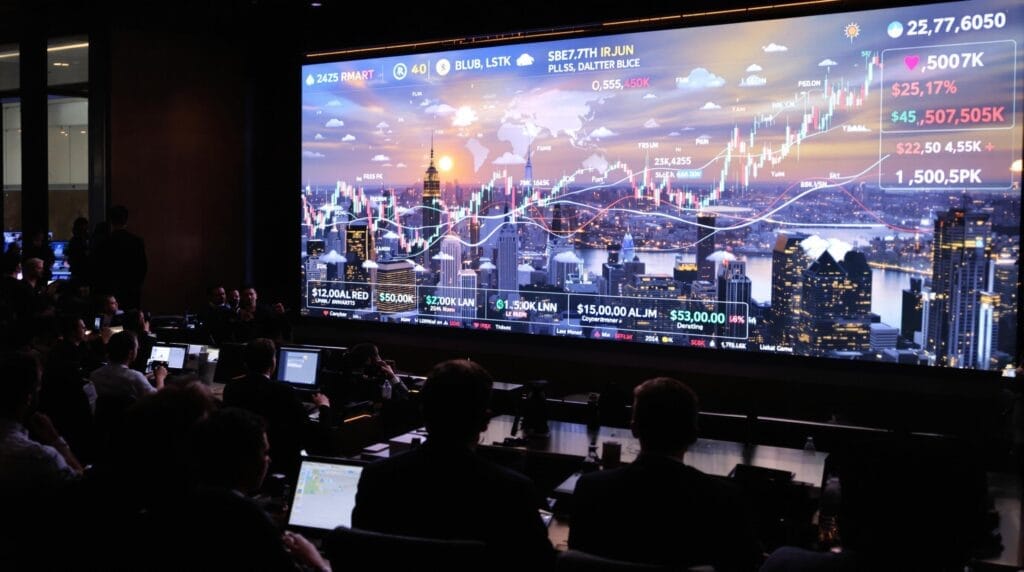Governments are getting into Bitcoin, sort of. Standard Chartered Bank says they’re buying shares of MicroStrategy (MSTR), a company that holds a lot of Bitcoin. This indirect buying helps support the bank’s big prediction: Bitcoin hitting $500,000 before President Trump finishes his term in 2029.
- Standard Chartered predicts Bitcoin will reach $500,000 by 2029, driven by institutional investment. This prediction is based on the increasing involvement of large investors.
- Governments are indirectly investing in Bitcoin by purchasing shares of MicroStrategy, a company holding significant Bitcoin reserves. This strategy allows them to gain exposure without direct purchases.
- Several government entities, including pension funds from Norway, Switzerland, and the U.S., have added MicroStrategy shares, indicating growing interest in Bitcoin.
Geoffrey Kendrick, who heads digital assets research at Standard Chartered, wrote about this. He looked at the latest reports big investors file with the U.S. government (called 13F filings). He thinks these filings back up the idea that Bitcoin will reach that half-million mark. More big players are getting involved, he said. As more people can buy Bitcoin and its price swings less, investors will put more money into it. They are starting from a position where they don’t own much Bitcoin now.
The 13F reports for the first three months of this year showed something interesting. Buying Bitcoin directly through new investment funds (like Bitcoin ETFs) wasn’t that exciting, Kendrick noted. But the increase in who owns MSTR shares? That was “very encouraging,” he said. It seems some governments might buy MSTR because rules in their area don’t let them buy Bitcoin directly. It’s like wanting a dog but your apartment building says no, so you buy a share in a company that owns a whole kennel. Not quite the same, but you get some exposure.
Take the State of Wisconsin’s investment group. They sold all their shares in a big Bitcoin ETF (BlackRock’s IBIT). That was a chunk of Bitcoin, about 3,400 coins worth. Meanwhile, a fund from Abu Dhabi (Mubadala) slightly upped its IBIT holdings, but it was a small move. The real action was in MSTR.
Several government groups added MSTR shares in that first quarter. Norway’s big pension fund, the Swiss National Bank, and South Korea’s pension people each added shares worth about 700 Bitcoin. U.S. state retirement funds in places like California, New York, North Carolina, and Kentucky added shares equal to about 1,000 Bitcoin combined. Sweden and Liechtenstein made small increases. And get this: France and Saudi Arabia bought MSTR for the very first time. Their buys were small, but it shows more governments are looking at getting Bitcoin exposure this way.
Kendrick sees these quarterly reports as a good test. They show if Bitcoin is attracting new kinds of big buyers as the market grows up. This is key to his $500,000 price target. He put it simply: When big institutions buy Bitcoin, the price usually goes up. It’s not rocket science, just supply and demand playing out on a grand scale.
Besides the big Bitcoin call, Kendrick has made other predictions. He thinks another crypto coin, BNB, could hit $2,775 by 2028. He sees Avalanche’s token (AVAX) reaching $250 by 2029. And he believes XRP could climb to $12.50 by 2028. He did lower his prediction for Ether, now seeing it at $4,000 in 2025. He also expects the total market for stablecoins (crypto coins tied to a stable asset like the dollar) to grow huge, maybe hitting $2 trillion by the end of 2028. The man makes a lot of calls, doesn’t he?
It’s worth noting, Kendrick told The Block last month that neither he nor his research team at Standard Chartered own any digital assets themselves. They just study the market and make their best guesses. It’s like being a sports analyst who doesn’t play the game, just watches the stats and predicts the winner. Keeps things clean, I suppose.

